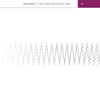Seth Horvitz, "Eight Studies for Automatic Piano"
 This is a case in which I went into listening to the album with some trepidation. While I’m no stranger to extremely conceptual works, knowing that this was based upon heavily programmed graphic piano scores, and that also that it included a link to a downloadable "listener's guide," I was concerned it was going to be a matter of concept over enjoyment. Thankfully, that wasn't an issue at all.
This is a case in which I went into listening to the album with some trepidation. While I’m no stranger to extremely conceptual works, knowing that this was based upon heavily programmed graphic piano scores, and that also that it included a link to a downloadable "listener's guide," I was concerned it was going to be a matter of concept over enjoyment. Thankfully, that wasn't an issue at all.
After quickly glimpsing at the 20 page guide and finding out this partially represents Horvitz' Masters thesis in Electronic Music and Recording Media, I made the conscious decision to listen to the album at first without any sort of supplementary knowledge, to judge it purely as a musical piece first, and then to focus on the esoteric details later.
The entire work is a concert performance using a Yamaha grand piano, sequenced via MIDI into tight, inhumanly precise patterns and melodies, all of which utilize different conceptual structures.The result is an odd amalgamation of the organic, natural sounding piano notes in a concert hall setting, but being driven an overly precise mechanical construct that completely changes the presentation and nature of the compositions.
For example, the mostly mid-register notes of "Study No. 13:Echoes"plays with the ideas of echoes:while the notes are allowed to echo on their own in natural space, the programming also forces echoing, repetitive notes that descend in dynamic, repeating the previous note at a lighter volume again and again.The extremely tight clusters of sounds on "Study No. 29:Tentacles" bounce around in some manner of structured chaos.At times it sounds as if a human could play along, but then the short and clipped groupings make that an impossibility.
"Study No. 1:Octaves, Systematically Filled and Folded" is perhaps my favorite piece on here, and it also stands out as the most unique sounding.While it features drastically shifting tempos and a "constructed binary form," I'll say it reminds me of something far more pedantic.It's a dead ringer for the sound effects on the old Galaga arcade game, which I have always loved.Regardless of its complex underlying structure, the fact that this grand piano is manipulated to sound like early digital computer sounds alone makes it a unique and compelling work.
The long closer, "Study No. 99:Strumming Machine," obviously references Charlemagne Palestine's work, but takes the same idea into a very different realm.While Palestine's work was heavily dependant upon, but limited to, the human performer, Horvitz is able to surpass that limitation via cold electronic precision.While the pacing is different, the overlapping tones and reverberations that defined Palestine's composition can still be heard, though of a distinctly different color, making it a different, but no less fascinating, variation on the same theme.
Admittedly, while I find this kind of intellectual work fascinating, I have such a limited repertoire when it comes to music theory and the like that a lot of the descriptions included with these pieces went right over my head.But, that's why this is a great album:I didn't need to be able to deconstruct the complexities of the work to enjoy it, I could do so simply at face value.
samples:
- Study No. 13: Echoes
- Study No. 1: Octaves, Systematically Filled and Folded
- Study No. 99: Strumming Machine
 



